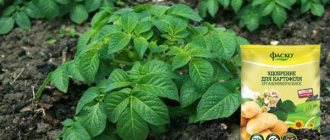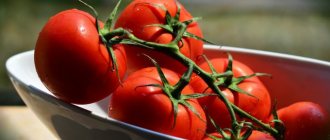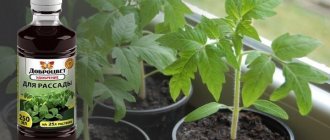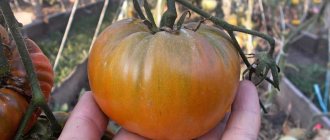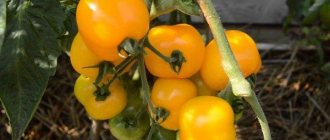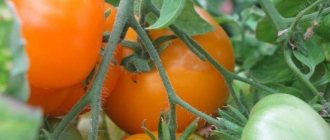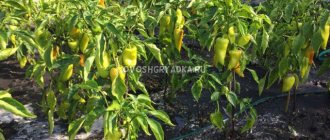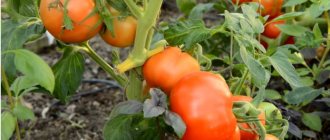Vegetable growing » Tomatoes
0
6502
Article rating
Kira Stoletova
Nightshade crops, which include tomatoes, require balanced fertilizing with mineral fertilizers for full growth. Among the effective complex fertilizers, superphosphate is distinguished. It is used for seedlings and adult plants. Feeding tomatoes with superphosphate will improve their overall growth and fruiting.
Feeding tomatoes with superphosphate
Types of superphosphate
Among all phosphorus-containing fertilizers, superphosphate occupies a leading position. It is what gardeners most often use to feed various vegetable and berry crops. However, superphosphate also comes in different forms. When you come to the store you can see simple and double superphosphate. These fertilizers differ in their composition, purpose, and method of application:
- Simple superphosphate contains about 20% of the main trace element, as well as some amount of sulfur, magnesium and calcium. Manufacturers offer this fertilizer in powder and granular forms. It is perfect for soil of any nutritional value. Tomatoes are always responsive to fertilizing with simple superphosphate. It can be used during autumn or spring digging of soil, for application into a hole during planting of seedlings, for root and foliar feeding of tomatoes.
- Double superphosphate is a highly concentrated fertilizer. It contains about 45% easily digestible phosphorus. In addition to the main microelement, it contains magnesium, calcium, iron and some other substances. Used at the stage of soil preparation for growing tomatoes, as well as for feeding tomatoes by watering at the root no more than 2 times during the entire growing season. The substance can replace simple superphosphate when the concentration of the solution is halved.
Important! Double superphosphate is more often used for plants lacking phosphorus.
Single and double superphosphate can be found in powder and granular forms. The substances can be used in dry form for incorporation into the soil or in the form of an aqueous solution, extract for watering and spraying tomatoes. It is recommended to add double superphosphate to the soil in the fall so that it has time to spread throughout the entire soil mass, thereby reducing the concentration of the main substance.
On sale you can find ammoniated, magnesized, boron and molybdenum superphosphate. In addition to the main substance, these types of fertilizer contain additional substances - sulfur, potassium, magnesium, boron, molybdenum. They can also be used to feed tomatoes at various stages of cultivation. Thus, ammoniated superphosphate is recommended to be added to the soil when planting seedlings for better rooting of plants.
Useful properties for tomatoes
Phosphorus is one of the main nutritional elements of plant organisms and is vital at all stages of development. Tomatoes are a crop that is especially sensitive to its deficiency. Application of superphosphate:
- gives the plant energy;
- allows metabolic processes and photosynthesis to proceed normally;
- promotes the formation and strengthening of the root system of tomatoes;
- slows down the aging of plants;
- accelerates the formation of flower brushes;
- with additional doses of superphosphate, tomatoes are transferred from the vegetative to the generative stage of development during fattening;
- improves the taste, aroma, color of fruits, promotes the accumulation of sugars and vitamins;
- makes plants stronger.
Tomatoes are especially sensitive to phosphorus deficiency in the early stages of development, during root formation.
Adding microelements to the soil
To grow tomato seedlings, soil can be prepared by mixing sand, turf soil and peat. The resulting mixture must be disinfected and filled with nutrients. So, to obtain a good, nutritious substrate, you need to add 1 part turf soil and 2 parts sand to 3 parts peat. Additionally, you can add sawdust treated with boiling water in the amount of 1 part.
Fertilizers must be added to the soil for growing seedlings. To 12 kg of substrate you should add 90 g of simple superphosphate, 300 g of dolomite flour, 40 g of potassium sulfate and 30 g of urea. The resulting microelement mixture will contain all the necessary substances for the successful growth of strong seedlings.
The soil in which tomato seedlings are to be planted also needs to be filled with minerals. During autumn digging, 50-60 g of simple superphosphate or 30 g of double fertilizer must be added to the soil for every 1 m2. Substances should be added directly into the hole before planting seedlings at the rate of 15 g per plant.
Important! In acidic soils, phosphorus is not absorbed, so the soil must first be deoxidized by adding wood ash or lime.
It is worth noting that sprinkling superphosphate on top of the soil is not effective, since tomatoes can only absorb it when wet at the depth of the roots or when liquid fertilizer is sprayed on the leaves of the plant. That is why, when applying fertilizer, it is necessary to embed it in the soil or prepare an extract or aqueous solution from it.
Signs of Phosphate Deficiency
Tomatoes grow well in acidic soils. It is on such soils that phosphorus deficiency is observed. A number of symptoms of phosphorus deficiency coincide with nitrogen deficiency:
- suppressed growth of young plants;
- shoots are short and thin;
- leaves fall prematurely;
- flowering and ripening are delayed.
Signs of phosphorus deficiency spread from bottom to top in plants.
Symptoms of critical phosphorus deficiency:
- the leaves are covered with a purple border;
- dark spots appear on the stems;
- leaves curl and darken.
Similar signs may appear in plants that have been exposed to frost, since in the cold the roots do not absorb phosphorus well. After the weather warms up, plants usually turn green again. But if this does not happen, a hood will be required.
Feeding seedlings
The first feeding of tomatoes with fertilizer containing phosphorus must be done 15 days after planting young plants. Previously, it was recommended to use only nitrogen-containing substances. The second feeding of seedlings with phosphorus should be done 2 weeks from the day of the previous application of fertilizers.
For the first feeding, you can use nitrophoska, which will contain the required amount of potassium, phosphorus and nitrogen. This fertilizer is diluted in water based on the ratio: 1 tablespoon of substance per 1 liter of water. This volume of liquid is enough to water 35-40 plants.
You can prepare a fertilizer similar in composition to nitrophoska by mixing 3 tablespoons of superphosphate with 2 tablespoons of potassium sulfate and the same amount of ammonium nitrate. Such a complex will contain the necessary substances for the growth and development of tomato seedlings. Before adding, all of these components must be dissolved in 10 liters of water.
You can also use Foscamide in combination with superphosphate for the first feeding of tomato seedlings. In this case, to obtain fertilizer, it is necessary to add substances in an amount of 30 and 15 g, respectively, to a bucket of water.
For the second feeding of tomato seedlings, you can use the following phosphate fertilizers:
- if the seedlings look healthy, have a strong trunk and well-developed foliage, then the drug “Effekton O” is suitable;
- if there is a lack of green mass, it is recommended to feed the plants with Atlet;
- If the tomato seedlings have a thin, weak stem, then it is necessary to feed the tomatoes with superphosphate, prepared by dissolving 1 tablespoon of the substance in 3 liters of water.
After two mandatory fertilizings, tomato seedlings are fertilized as needed. In this case, you can use not only root, but also foliar feeding. Phosphorus is perfectly absorbed through the leaf surface, so after spraying tomatoes with a solution of superphosphate or other phosphate fertilizer, the effect will occur within a few days. You can prepare a solution for spraying by adding 1 spoon of the substance to 1 liter of hot water. This solution is highly concentrated. It is infused for 24 hours, after which it is diluted in a bucket of water and used to spray seedlings.
A week before the intended planting of plants in the ground, it is necessary to carry out another root feeding of the seedlings with fertilizer prepared from superphosphate and potassium sulfate. To do this, add 1.5 and 3 tablespoons of each substance to a bucket of water, respectively.
Important! Young tomatoes do not absorb the substance well in a simple form, so it is better to use double granular superphosphate to feed seedlings.
When preparing fertilizing, its amount should be halved.
Thus, phosphorus is extremely necessary for tomatoes at the seedling stage. It can be obtained by using ready-made complex preparations or by adding superphosphate to a mixture of mineral substances. Superphosphate can also be used as the main and only component for the preparation of root and foliar fertilizers.
On what soils to use
Phosphorus in the fertilizer is in a form in which superphosphate can be used for any soil. It always remains available to plants, and they can absorb it in the required quantity. The fertilizer is most effective on fertile soils with a neutral or alkaline reaction. But on acidic soils, its absorption by plants is a little difficult.
With an acid reaction, the absorption of phosphorus by the roots slows down, so before applying the drug, the acidity of the soil must first be leveled with ash (200 g/1 m² of area) or lime (0.5 kg/m²). After leveling the acidity, superphosphate is added no earlier than after 1 month. Otherwise, the effectiveness of the fertilizer will be significantly reduced.
In acidic soil, the effect of superphosphate can have unpredictable consequences. This is especially true for inexpensive mixtures, for the production of which manufacturers use non-pure raw materials.
In any other soil, nothing bad will happen, but in an acidic environment, such fertilizer can turn into iron phosphate, which is why it becomes unavailable to plants. Therefore, if there is a noticeable deficiency of phosphorus in the soil, it is better to use more expensive preparations. But if you are sure that the acidity of your soil is not increased, then you can use any type of superphosphate.
Feeding tomatoes after planting
Feeding tomato seedlings with phosphorus is aimed at developing the plant's root system. Seedlings do not absorb this microelement well, so superphosphate must be used in the form of an extract or solution. Adult tomatoes are able to absorb simple and double superphosphate well. Plants use 95% of phosphorus for fruit formation, which is why superphosphate should be actively used during flowering and fruiting.
10-14 days after planting tomatoes in the ground, you can feed them. To do this, you should use a complex fertilizer containing nitrogen, potassium and phosphorus or organic matter with the addition of superphosphate. Thus, mullein infusion is often used: add 500 g of cow manure to 2 liters of water, then leave the solution for 2-3 days. Before using mullein for tomatoes, dilute it with water 1:5 and add 50 g of superphosphate. This tomato fertilizer will contain the entire complex of essential minerals. It can be used 2-3 times during the entire growing period.
Ways to use fertilizer in the garden
To enrich the soil with phosphorus, continuous fertilizing is carried out throughout the entire area of the garden. Fertilizer is used in the fall after harvesting and clearing the beds of dry vegetation . The average dosage for most crops is:
- 50 g of superphosphate per 1 square meter for basic soil preparation.
- 70 – 100 g/m2 with crop rotation, that is, on depleted soil.
Application method:
To save fertilizer, they can be applied not to the entire area, but only to future beds.
- The required amount of granules is evenly scattered over the garden plot and dug up to a depth of 20 cm and left until spring. In the cold season, the granules dissolve poorly, but when the snow melts and there is enough moisture, the fertilizer will become available to the plants. If superphosphate is added in the fall, then in the spring before planting, fertilizing is not carried out.
- It is not always possible to prepare a garden in the fall. Then the work is carried out in the spring, but no later than 2 weeks before planting. The application rate is the same as in the fall.
In addition to pre-planting nutrition, plants need phosphorus during different phases of growth and fruiting. In addition to general recommendations, experienced gardeners have come up with a way to improve the availability of the element for plants.
How to determine phosphorus deficiency
To feed tomatoes, organic fertilizers with the addition of superphosphate or complex mineral fertilizers containing phosphorus are often used. The frequency of their use depends on the fertility of the soil and the condition of the plants. As a rule, on soils of average nutritional value, 2-3 fertilizing is used; on poor soils, 3-5 fertilizing may be needed. However, sometimes tomatoes receiving a complex of microelements show symptoms of phosphorus deficiency. In this case, it is recommended to use superphosphate fertilizer once again.
In tomatoes, signs of phosphorus deficiency are:
- change in leaf color. They become dark green, sometimes acquiring a purple tint. Also a characteristic sign of phosphorus deficiency is the leaves curling inward;
- the tomato stem becomes brittle and brittle. Its color becomes violet as phosphorus starvation occurs;
- Tomato roots wither and stop consuming nutrients from the soil, causing the plants to die.
You can see the lack of phosphorus in tomatoes and hear comments from an experienced specialist on solving the problem in the video:
If such symptoms are observed, the tomatoes must be fed with superphosphate. To do this, prepare a concentrate: a glass of fertilizer per 1 liter of boiling water. Leave the solution for 8-10 hours, then dilute it with 10 liters of water and pour 500 ml of tomatoes at the root for each plant. Superphosphate extract prepared according to the classic recipe is also excellent for root feeding.
You can also compensate for phosphorus deficiency by foliar feeding: a spoonful of superphosphate per 1 liter of water. After dissolution, dilute the concentrate in 10 liters of water and use for spraying.
When is foliar feeding carried out?
The application of foliar fertilizers is used as an additional method of providing plants with necessary minerals and trace elements. Indeed, in some cases, nutrients from the soil do not always reach the leaves and fruits due to poor absorption and other characteristics of the soil or environmental conditions.
Read also: Description, characteristics, sowing seedlings, fertilizing, yield, photos, videos and the most common diseases of tomatoes of the “Honey Fingers F1” variety
Foliar feeding should be done in the following situations:
- Increased soil acidity or alkaline soil reaction. Because of this, many nutrients cannot be absorbed by the plant.
- The appearance of visible signs of a deficiency of one or another microelement, provided that they are regularly added to the soil.
- Features of the acid-base environment of the soil, as a result of which important macroelements, such as phosphorus and potassium, are unavailable to tomatoes, since they are interconnected.
- Planned on the eve of flowering.
- The impossibility of root fertilization or its ineffectiveness. This can happen at high or low soil temperatures, high humidity and poor aeration. And also in case of damage to the integrity of the root system of plants by various pests or during transplantation.
It is best to fertilize in the evening to prevent the leaves from burning.
Superphosphate extract
Superphosphate can be used as an extract for feeding tomatoes. This fertilizer has an easily accessible form and is quickly absorbed by tomatoes. You can prepare the hood using the following technology:
- add 400 mg of superphosphate to 3 liters of boiling water;
- Place the liquid in a warm place and stir periodically until the substance is completely dissolved;
- Infuse the solution for 24 hours, after which it will look like milk in appearance, which means the hood is ready for use.
The instructions for using the extract recommend diluting the prepared concentrated solution with water: 150 mg of extract per 10 liters of water. You can make a complex fertilizer by adding 1 spoon of ammonium nitrate and a glass of wood ash to the resulting solution.
When to use superphosphate for tomatoes
Superphosphate is characterized by a prolonged action. In order for it to start working, the soil must be fertilized in the previous season. Fertilizer should be applied to the entire area once every 2-3 years.
Separately, tomatoes are given phosphorus:
- if the element was not brought in for digging in one of the previous seasons;
- when a plant shows a clear lack of phosphorus during the growing season.
If an element is missing:
- tomato shoots become thin and short;
- flowering and fruit ripening are delayed;
- leaves become smaller;
- anthocyanin color appears.
Nowadays, inorganic fertilizers are rarely applied entirely during digging, preferring to be added to the holes. According to the instructions for use, it is recommended to sprinkle superphosphate under each tomato bush:
- plain – 40 g;
- double – 20 g.
But such a fertilizer will begin to fully act only in the next season, and in the year of application it is ineffective. So you will have to feed the tomatoes throughout the growing season, otherwise there will be no good harvest.
Consequences of excess element
Some gardeners believe that it is impossible to overfeed tomatoes with superphosphate. The plant itself will figure out how much of the element it needs, the rest will lie in the ground, like in a pantry. This is wrong. With excess phosphorus:
- the absorption of many microelements is blocked, in particular copper, which poses a particular danger as it provokes late blight;
- the leaves become crooked, small, covered with yellow spots that look like burns;
- there is abnormally strong growth of tomato roots, which is also not good;
- with unusually abundant flowering, few ovaries are formed;
- Early ripening of fruits occurs when they have not had time to gain marketable weight and accumulate enough sugars.
Other phosphate fertilizers
Superphosphate is an independent fertilizer that can be purchased in specialized stores and used as a fertilizer for tomatoes. However, farmers are also offered other fertilizers with a high phosphorus content:
- Ammophos is a complex of nitrogen (12%) and phosphorus (51%). The fertilizer is water-soluble and easily absorbed by tomatoes.
- Nitroammophos contains equal amounts of nitrogen and phosphorus (23%). It is necessary to use fertilizer when the growth of tomatoes is slow;
- Nitroammophoska contains a complex of nitrogen with potassium and phosphorus. There are two brands of this fertilizer. Brand A contains potassium and phosphorus in the amount of 17%, brand B in the amount of 19%. Using nitroammophoska is quite simple, since the fertilizer is easily soluble in water.
These and other phosphate substances must be used in accordance with the instructions for use, since increasing the dosage can lead to excess microelement content in the soil. Symptoms of phosphorus oversaturation are:
- accelerated growth of stems without a sufficient number of leaves;
- rapid aging of the plant;
- The edges of tomato leaves turn yellow or brown. Dry spots appear on them. Over time, the leaves of such plants fall off;
- tomatoes become especially demanding of water and, at the slightest shortage, begin to actively wither.
